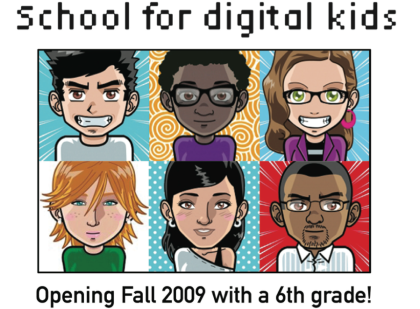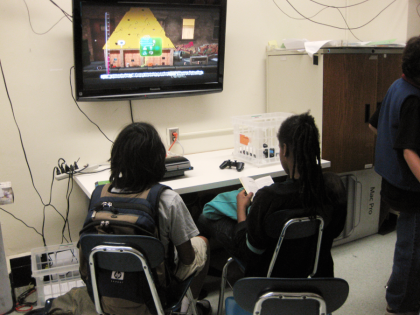Digital inequality scholarship is well-intentioned. It debunks myths about digital media’s inherent egalitarianism and draws attention to the digital dimensions of social inequalities. Digital inequality scholars have shown, for example, that people with access to networked media use those technologies in different ways, some of which are thought to be more beneficial than others. They have highlighted how differences in skills and quality of access shape use. And they have rightly attacked the stereotype of the digital generation. These are important contributions for which we should be grateful.
Yet digital inequality scholarship is also limited in some fundamental, and I believe hazardous, ways. To defend these claims, I will draw on an in-depth ethnographic study of an ambitious attempt to combat digital inequality: a new, well-resourced, and highly touted public middle school in Manhattan that fashions itself as, “a school for digital kids.” It is hard to imagine a more concerted attempt to combat digital inequality, and yet the school paradoxically helped perpetuate many of the very social divisions it hoped to mend. In-depth ethnographic studies can help us understand these outcomes, and they can provide us with tools for forming more accurate conceptions of relations between digital media and social inequalities.

I will call this school, which opened in the fall of 2009, the Downtown School for Design, Media and Technology, or the Downtown School for short. Supported by major philanthropic foundations, and designed by leading scholars and practitioners from the learning sciences as well as media technology design, the Downtown School braided digital media practices, and especially media production activities, throughout its curriculum. They had enviable financial, technological, and intellectual resources, and they recruited an atypically diverse student body for a New York City public school. About half the students came from privileged families where at least one parent worked in a professional field and held an advanced degree. And about 40-percent of students came from less-privileged families that qualified for free or reduced-price lunch; these parents and guardians often had some or no college education and worked in comparatively low-paying service work. All students took a required game design course, and the school’s entire suite of after-school programs were devoted to making, hacking, remixing, and designing media technology.
Digital inequality scholarship played a role in the formation the Downtown School and similar interventions. Concepts such as the digital divide, the “participation gap” (Jenkins et al. 2006), the “digital production gap” (Schradie 2011), or the “participation divide” (Hargittai and Walejko 2008) implicitly, if not explicitly, recommend and legitimate interventions such as the Downtown School. Since digital inequality scholars argue that skill differentials play a large role in producing digital inequalities, educational practitioners understandably craft interventions to reduce these differentials.

According to such a framework, the Downtown School was successful in many ways. Both boy and girl students from diverse economic and ethnic backgrounds learned to use digital media in new ways. In particular, students learned to use digital tools to be producers, rather than just consumers, of digital media. Through the lens of concepts like the “participation gap,” the school appears successful and should be quickly replicated.
The problem though – and here is why we need ethnography – is that while the Downtown School arguably helped close the participation gap, it also helped perpetuate historical social divisions, especially those rooted in gender and racialized social class. When the Downtown School opened, it attracted three boys for every two girls; three years after opening, the ratio rose to two-to-one. Only one girl student regularly participated in the school’s after-school programs focused on media production; most regular participants were boys from privileged families. By the end of the first year, all of the economically less-privileged boys in one of the school’s main cliques had left the school for larger, less-resourced schools that had a greater diversity of curricular and extra-curricular offerings as well as more of a dating scene. By the end of the second year, many of the less-privileged girls from another of the main cliques had also left the school. While their reasons for leaving were complex, they and their families suggested in interviews with me that the Downtown School was not a ‘good fit.’ By contrast, nearly all of the privileged students remained enrolled, and many of their parents were enthusiast boosters for the school.
Why were many students, and especially many of the less-privileged students, not able or unwilling to take advantage of the purportedly beneficial opportunities afforded by the Downtown School? Digital inequality frameworks do not provide a satisfying way to answer this question. They do not see many of the factors that matter to people in different situations, nor the nexus of conditions and forces that shape what people do, and do not do, with and without digital media. Ethnography, in contrast, casts a much wider net that can help account for these conditions and processes. A few more examples will help clarify this point.
On the ground, I observed and documented what students were doing when they were not taking advantage of the school’s purportedly beneficial activities. It turned out that most of the students spent their afternoon hours in familiar activities that predate the digital age: basketball practices, music lessons, swimming classes, learning a foreign language, dance classes, taking care of siblings and cousins, chores, and so forth. These activities meant a lot to students and their families, and many expressed a desire for the school to offer more diverse curricular and extra-curricular offerings. These activities were also integral to how students navigated and negotiated identity and difference with their peers at school (Sims 2014). This wider ecology of practices, as well as what participation and non-participation meant for those involved, would be invisible if one were to study the Downtown School using the digital inequality framework. And what a digital inequality approach would have captured and championed would have mostly reflected the interests and practices of those who were most privileged.
One can still argue that social scientists, policy makers, and educational practitioners should do all that they can to close digital inequalities such as the participation gap. One can argue that doing so is in the best interest of those currently on the wrong side of the chasm. One can argue that treating digital inequalities is akin to dealing with a public health concern, or, more aptly, that it should be folded into broader efforts to mandate STEM education amongst all contemporary school children. In short, digital inequality scholars can admit that there is a prescriptive character to their efforts and that treatment is justified because it is in the best interest of the public as well as those being treated.
This is a debate that can be had but it is not the debate that digital inequality scholars are currently having. In its current form, the digital inequality debate escapes these issues because it assumes that certain decontextualized “uses” will be universally appealing to people once barriers to participation – lack of quality access, skills, etc. – are removed. There is a sort of technology-focused ethnocentrism to these assumptions that prevents this potentially uncomfortable debate from ever taking place. If digital inequality scholars were to acknowledge the prescriptive character of their scholarship, a host of thorny ethical dilemmas would quickly surface: To what degree should social scientists, policy-makers, and educational practitioners force people to partake in participatory culture? To what extent do the ends justify the means? What exercises of power are legitimate? What liberties should be granted to those identified for treatment? And so on.
These are difficult questions, and my guess is that most digital inequality scholars do not want to address them. My own feeling is that scholars should be extremely cautious in pushing for such treatments, whether domestically or abroad, even if they feel that their medicine would be in the best interest of the treated. The histories of various missionary and colonial endeavors – to name just a few charged examples – make the ethical and political hazards of such an enterprise all too clear.
Note: This was originally posted at Ethnography Matters.
References
Hargittai, E. & Walejko, G., 2008. The Participation Divide: Content Creation and Sharing in the Digital Age. Information, Communication & Society, 11(2), pp.239–256.
Jenkins, H. et al., 2006. Confronting the Challenges of Participatory Culture: Media Education for the 21st Century, Chicago, IL: The John D. and Catherine T. MacArthur Foundation.
Schradie, J., 2011. The Digital Production Gap: The Digital Divide and Web 2.0 Collide. Poetics, 39(2), pp.145–168.
Sims, C., 2012. The Cutting Edge of Fun: Making Work Play at the New American School. University of California, Berkeley. http://www.ischool.berkeley.edu/files/sims_2012_cuttingedgeoffun.pdf
Sims, C., 2014 (forthcoming). From Differentiated Use to Differentiating Practices: Negotiating Legitimate Participation and the Production of Privileged Identities. Information, Communication & Society. http://www.tandfonline.com/doi/full/10.1080/1369118X.2013.808363

THIS: “the digital inequality debate escapes these issues because it assumes that certain decontextualized “uses” will be universally appealing to people once barriers to participation – lack of quality access, skills, etc. – are removed”
Exactly! The internet is huge, but many talk about it like it’s a kind of global monoculture. The reality is that people participate in very different ways. I like the idea of social media literacy- learning how to effectively garner an audience and communicate. But I’d also like to see a significant expansion of the idea of “differential use”
Reblogged this on MOOC Madness and commented:
Not about MOOCs per se but digital inequalities favoring learners from privileged and social backgrounds are built into the xMOOC model ~ no less, just somewhat differently than into the bricks and mortar model